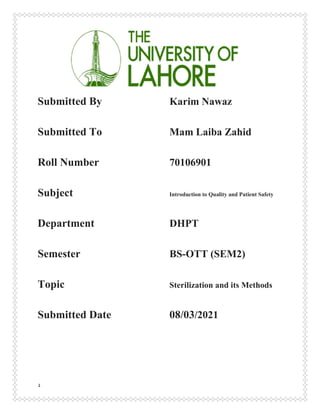
Sterilization converted-2
- 1. 1 Submitted By Karim Nawaz Submitted To Mam Laiba Zahid Roll Number 70106901 Subject Introduction to Quality and Patient Safety Department DHPT Semester BS-OTT (SEM2) Topic Sterilization and its Methods Submitted Date 08/03/2021
- 2. 2 Sterilization Sterilization is defined as a process of complete elimination or destruction of all forms of microbial life (i.e., both vegetative and spore forms), which is carried out by various physical and chemical methods. Technically, there is reduction ≥106 log colony forming units (CFU) of the most resistant spores achieved at the half-time of a regular cycle. Chemical sterilant These are chemicals used for a longer duration (3–12 h) to destroy all forms of microbes, e.g., peracetic acid (PAA) (0.2%), glutaraldehyde (≥2.4%), ortho-phthalaldehyde (OPA) (0.55%), and hydrogen peroxide (7.5%). Disinfection Disinfection is defined as a process of complete elimination of vegetative forms of microorganisms except the bacterial spores from inanimate objects. Technically, there is reduction of ≥103 log CFU of microorganisms by this method without spores. High-level disinfectant (HLD) Used for shorter duration and able to kill 106 log microorganisms except spores, e.g., glutaraldehyde (≥2.0%), OPA (0.55%), hydrogen peroxide (7.5%), hypochlorite (650–675 ppm), and hypochlorous acid (400–450 ppm).
- 3. 3 Intermediate level disinfectant (ILD) These disinfectants act against Mycobacterium tuberculosis and are mainly used for noncritical items contaminated with blood/body fluids. Low-level disinfectant (LLD) LLDs are used to remove the vegetative form of bacteria, few fungi, and some enveloped viruses from the noncritical items, e.g., 3% hydrogen peroxide, quaternary ammonium compound, diluted glutaraldehyde, phenolics, etc. Decontamination and cleaning Decontamination is the process of removal of pathogenic microorganisms from objects so that they are safe to handle. Cleaning is defined as removal of visible soil (e.g., organic and inorganic materials) from the surfaces and objects. Technically, it achieves minimum reduction of ≥1 log CFU of microorganisms. Antisepsis Antisepsis is a process of removal of germs from the skin. When it is related to the patient’s skin, it means disinfection of living tissue or skin. When it is related to the health care worker, it means reduction or removal of transient microbe from the skin.
- 4. 4 Germicide It is the agent that destroys germs. It includes both antiseptics and disinfectants. The type of microorganism is identified from the prefix (e.g., virucide, fungicide, bactericide, sporicide, and tuberculocide). Physical Methods Heat Most reliable process. There are two major methods of using heat in sterilization which are dry heat and moist heat. The principle behind both of these methods is similar. Dry heat induces the denaturation of protein, oxidative damage and toxic effect due to the high level of electrolytes. Moreover, the dry heat can also damage the DNA of the microorganism. As a result, the microorganism got killed. Moist Heat kills the microorganisms by denaturation and coagulation of proteins. There are several factors that can influence the heat killing procedure. Dry Heat Red Heat Inoculation loops, wires, forceps tips, needles are needed to be sterilized to inhibit microbial contamination. These instruments are held in the flame of a Bunsen burner until they become red hot. Flaming Glass slides, scalpels, and mouths of culture tubes or conical flasks are passed through Bunsen flame without allowing them to become red hot.
- 5. 5 Auto Clave The invention of the autoclave sterilizer is attributed to Charles Chamberland, in 1879. Around that time, researchers started to understand the advantages of sterile surgery, and doctors needed a more reliable sterilization method than open flaming. The autoclave’s benefits were soon evident, and it became an essential part of every clinic and hospital. An autoclave is used to sterilize surgical equipment, laboratory instruments, pharmaceutical items, and other materials. It can sterilize solids, liquids, hollows, and instruments of various shapes and sizes. Autoclaves vary in size, shape and functionality. A very basic autoclave is similar to a pressure cooker; both use the power of steam to kill bacteria, spores and germs resistant to boiling water and powerful detergents. What is an Autoclave Used for? An autoclave chamber sterilizes medical or laboratory instruments by heating them above boiling point. Most clinics have tabletop autoclaves, similar in size to microwave ovens. Hospitals use large autoclaves, also called horizontal autoclaves. They’re usually located in the the Central Sterile Services Department CSSD) and can process numerous surgical instruments in a single sterilization cycle, meeting the ongoing demand for sterile equipment in operating rooms and emergency wards.
- 6. 6 Generating Steam and Steam Quality Steam is the autoclave’s sterilization agent. In our Sterilization Methods series, we explained the physics of steam and why it’s ideal for destroying microorganisms such as bacteria and spores. Part 1 of this post will explain how steam is generated for autoclaving purposes. Part 2 in this series will discuss the various types of autoclave steam supply and generation and when each is used.
- 7. 7